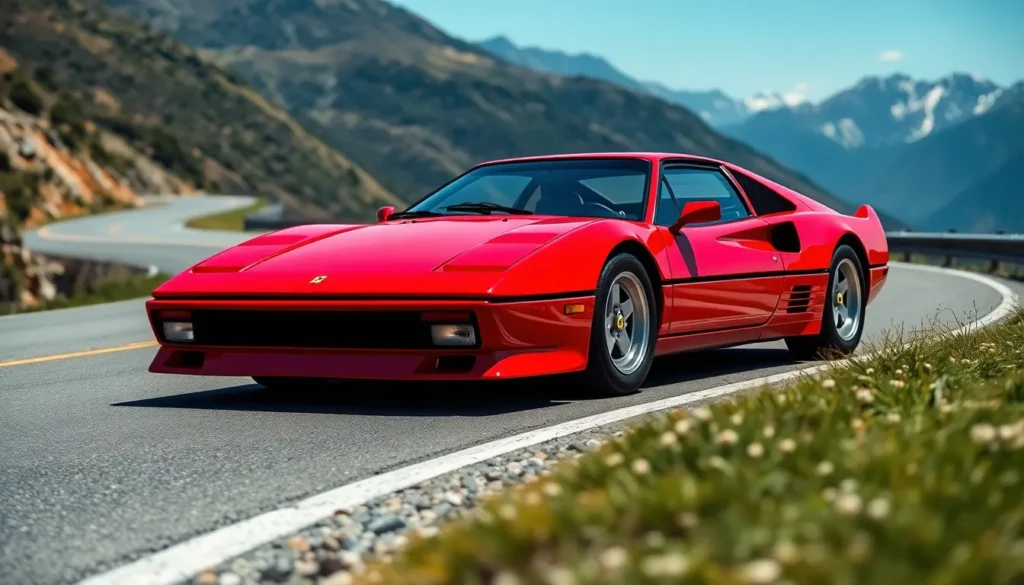We’ve witnessed countless supercars claim the title of “ultimate driving machine” but few command the reverence of the Ferrari 288 GTO. Born from Ferrari’s racing DNA in 1984, this wasn’t just another pretty face in Maranello’s lineup – it was a street-legal race car that redefined what a supercar could be.
The 288 GTO emerged during an era when manufacturers pushed boundaries to homologate their racing ambitions. Ferrari created something extraordinary: a twin-turbocharged V8 beast that delivered 400 horsepower in a lightweight carbon fiber and Kevlar body. With only 272 units ever produced, it became one of the most exclusive Ferraris ever built.
We’re diving deep into the legacy of this remarkable machine that bridged the gap between Ferrari’s legendary 250 GTO and the modern hypercar era. From its innovative construction to its astronomical auction prices today, the 288 GTO represents automotive perfection that continues to captivate collectors and enthusiasts worldwide.
Ferrari 288 GTO: A Racing Legend Born for the Road
Ferrari’s 288 GTO emerged from Maranello’s racing DNA to create the ultimate street-legal competition machine. Born in 1984 as a homologation special for Group B racing, this supercar bridged the gap between track-bred performance and road-going usability.
The 288 GTO’s development centered around Ferrari’s return to competitive racing after decades of Formula One focus. Engineers designed every component with dual purposes: dominating racetracks while maintaining street legality. This racing-first philosophy shaped everything from the car’s aerodynamics to its lightweight construction methods.
Engineering Excellence Meets Racing Heritage
Ferrari’s engineers crafted the 288 GTO using advanced materials that racing demanded. The body construction featured carbon fiber and Kevlar panels that reduced weight by 220 pounds compared to traditional steel construction. These materials weren’t just lighter – they offered superior strength and crash protection for racing environments.
The twin-turbocharged 2.8-liter V8 engine produced 400 horsepower at 7,000 rpm. This power figure represented a 40% increase over the naturally aspirated 308 GTB’s output. Turbocharging technology, refined through Ferrari’s Formula One experience, delivered explosive acceleration while maintaining reliability across racing distances.
Racing DNA in Every Component
Track-focused suspension systems defined the 288 GTO’s handling characteristics. Double wishbones at all four corners provided precise wheel control during high-speed cornering. Anti-roll bars and adjustable dampers allowed fine-tuning for different racing circuits and driving conditions.
Brembo ventilated disc brakes measured 295mm front and 282mm rear, delivering stopping power that matched the car’s acceleration capabilities. These racing-spec components ensured consistent performance during extended track sessions where lesser systems would fade.
Aerodynamic Innovation for Competition
Wind tunnel testing shaped the 288 GTO’s distinctive aerodynamic package. The front spoiler, side skirts, and rear wing generated meaningful downforce at racing speeds. NACA ducts integrated into the body panels directed cooling air to the engine and brakes without disrupting airflow.
The car’s drag coefficient of 0.32 balanced aerodynamic efficiency with high-speed stability. This figure represented optimal compromise between straight-line speed and cornering grip that racing demanded.
Limited Production Creates Legendary Status
Ferrari produced exactly 272 units of the 288 GTO between 1984 and 1987. Each car underwent hand assembly at Maranello using techniques developed for Ferrari’s Formula One program. Quality control processes ensured every vehicle met both street-legal requirements and potential racing specifications.
Production numbers remained intentionally limited to maintain exclusivity and racing homologation requirements. Group B regulations required manufacturers to build 200 road cars before competing, making the 288 GTO one of the rarest Ferrari models ever created.
Design and Styling Excellence
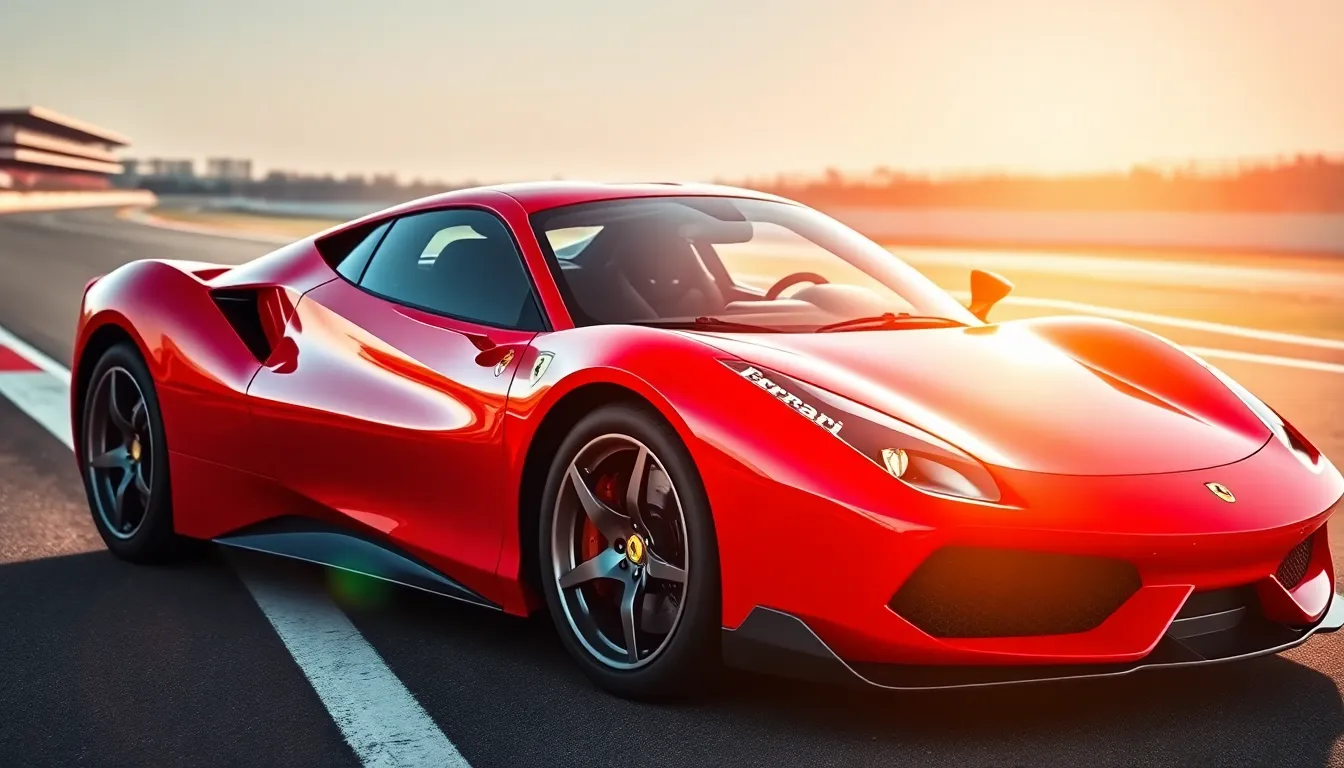
Design excellence defines every element of the Ferrari 288 GTO’s visual identity, creating a masterpiece that balances aggressive racing aesthetics with Italian craftsmanship. The supercar’s styling approach emphasizes functional beauty where each design element serves both performance and visual impact.
Exterior Design Philosophy
Aerodynamic efficiency drives the 288 GTO’s exterior design philosophy, building upon the 308 GTB’s foundation while incorporating radical performance enhancements. Engineers crafted the distinctive front air dam to channel airflow for optimal cooling and downforce generation at high speeds.
Wide fender flares accommodate the racing-spec tires and suspension geometry, extending beyond the standard 308’s bodywork by several inches. These muscular proportions communicate the car’s track-bred heritage while maintaining Ferrari’s signature proportions and elegance.
Functional vents punctuate the bodywork at strategic locations, including the hood-mounted NACA ducts that feed fresh air to the intercoolers. Side air intakes positioned behind the doors provide essential cooling for the twin-turbocharged V8 engine compartment.
The integrated rear spoiler emerges seamlessly from the engine cover, generating crucial downforce without disrupting the car’s visual flow. Distinctive tail lights borrowed from Ferrari’s contemporary models maintain brand continuity while the lower rear diffuser manages airflow beneath the vehicle.
Carbon fiber body panels replace traditional steel components in key areas, reducing weight while creating subtle visual texture differences that racing enthusiasts immediately recognize. This material choice reinforces the 288 GTO’s competition-focused identity.
Interior Craftsmanship and Layout
Racing-focused ergonomics define the 288 GTO’s interior layout, prioritizing driver engagement over luxury appointments found in standard Ferrari models. The cockpit design places all essential controls within easy reach during spirited driving sessions.
Lightweight Recaro sport seats provide exceptional lateral support during high-G cornering maneuvers, featuring distinctive perforated leather upholstery that reduces weight while maintaining comfort. These racing-derived seats position drivers optimally for track performance.
Carbon fiber trim elements appear throughout the cabin, reinforcing the car’s lightweight construction philosophy and creating visual connections to the exterior body panels. The dashboard layout eliminates unnecessary components to save weight and reduce distractions.
Essential gauges cluster around the steering wheel, providing critical engine and performance information at a peek. The analog speedometer reads to 300 km/h while the tachometer’s redline emphasizes the V8’s high-rev capabilities.
Minimal sound deadening materials create an intimate connection between driver and engine, allowing occupants to experience the twin-turbocharged powerplant’s distinctive sound signature. This approach reinforces the 288 GTO’s pure driving focus over refined comfort.
Engine Performance and Technical Specifications
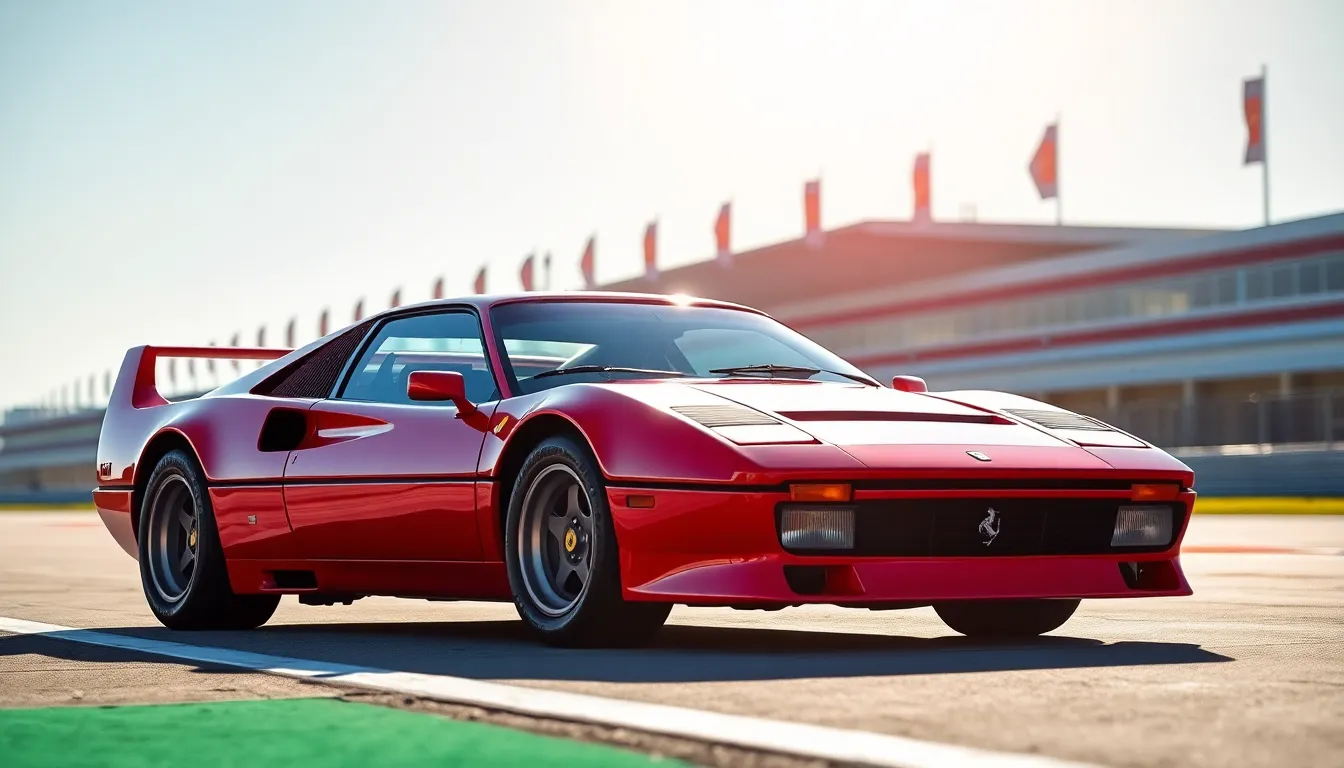
Ferrari’s engineering team transformed the 288 GTO into a formidable racing machine through its sophisticated powertrain design. The heart of this supercar delivers exceptional performance capabilities that defined its legendary status.
Twin-Turbocharged V8 Powerplant
Ferrari developed a 2.8-liter twin-turbocharged V8 engine specifically for the 288 GTO, marking the company’s first production turbo engine. Engineers positioned two IHI turbochargers to maximize power output while maintaining reliability under extreme conditions. The 90-degree V8 configuration features dry sump lubrication and four valves per cylinder operated by twin camshafts.
Boost pressure reaches 1.0 bar through the twin turbo system, generating peak power at 7,000 rpm. The engine produces maximum torque between 3,800 and 4,200 rpm, providing strong acceleration across the rev range. Ferrari’s fuel injection system delivers precise air-fuel mixtures for both performance and efficiency.
Each cylinder displaces 350cc with a compression ratio of 7.6:1, optimized for turbocharged operation. The aluminum block and heads reduce overall weight while providing excellent heat dissipation. Weber-Marelli electronic ignition manages timing for optimal combustion under varying load conditions.
Performance Metrics and Capabilities
The 288 GTO’s twin-turbo V8 delivers 400 horsepower at 7,000 rpm and 366 lb-ft of torque at 3,800 rpm. Top speed reaches 189 mph making it one of the fastest production cars of the 1980s. Acceleration from 0-60 mph occurs in just 4.9 seconds demonstrating the effectiveness of the turbocharged powerplant.
| Performance Metric | Specification |
|---|---|
| Power Output | 400 hp @ 7,000 rpm |
| Torque | 366 lb-ft @ 3,800 rpm |
| Top Speed | 189 mph |
| 0-60 mph | 4.9 seconds |
| Power-to-Weight Ratio | 1.39 hp per pound |
| Engine Displacement | 2.8 liters |
Weight distribution favors the rear with 42% front and 58% rear balance, optimizing traction during acceleration. The power-to-weight ratio of 1.39 hp per pound surpasses many contemporary supercars through the combination of lightweight construction and substantial power output. Quarter-mile times reach 13.1 seconds at 108 mph showcasing the engine’s explosive acceleration capabilities.
Driving Experience and Handling
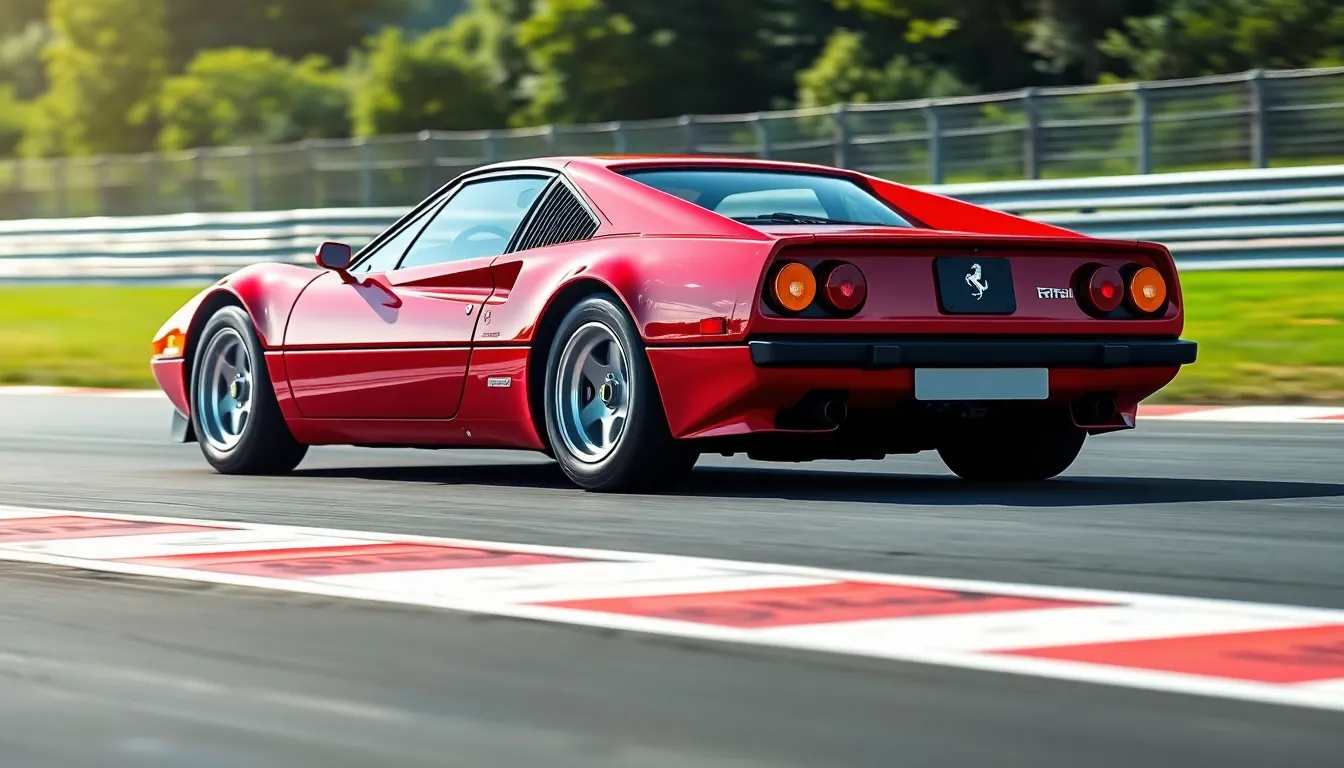
The Ferrari 288 GTO delivers an uncompromising driving experience that transforms every journey into a motorsport adventure. Behind the wheel, drivers encounter raw mechanical feedback that connects them directly to the road surface through precise steering and suspension tuning.
On-Road Performance
Street driving in the 288 GTO reveals a supercar built without compromise for daily comfort. The twin-turbocharged V8 produces immediate throttle response once the turbos spool up around 3,000 rpm, delivering explosive acceleration that pushes occupants deep into the Recaro racing seats. Turbo lag characteristics require precise throttle modulation in urban environments, making smooth progress a skill that rewards experienced drivers.
Road surface imperfections transmit directly through the chassis thanks to the track-tuned suspension setup. The steering wheel communicates every detail of the pavement texture, tire grip levels, and front axle loading through unfiltered mechanical feedback. Cornering dynamics showcase the 288 GTO’s racing DNA with minimal body roll and exceptional directional stability at high speeds.
Braking performance on public roads demonstrates the effectiveness of the ventilated disc system, providing consistent stopping power even during aggressive driving sessions. The pedal feel remains firm and progressive, allowing drivers to modulate brake pressure precisely when handling traffic or mountain roads.
Track-Focused Engineering
Circuit environments reveal the 288 GTO’s true purpose as a homologation special designed for Group B racing regulations. The aerodynamic package generates meaningful downforce at track speeds above 80 mph, pressing the lightweight chassis firmly onto the racing surface for enhanced grip levels.
Suspension geometry optimizes tire contact patches during cornering loads, maintaining traction even when pushing the limits of the Pirelli P7 racing compounds. The front and rear anti-roll bars work together to minimize weight transfer, keeping all four wheels engaged during rapid direction changes through technical sections.
Track sessions demonstrate the effectiveness of the dry sump lubrication system, which prevents oil starvation during sustained high-g cornering and braking zones. Engine oil temperatures remain stable even during extended circuit use, thanks to the sophisticated cooling system designed for racing applications.
The limited-slip differential distributes power effectively between the rear wheels, allowing drivers to exploit the full 400 horsepower output when exiting corners. Traction control systems weren’t available in 1984, requiring pure driver skill to manage the turbocharged power delivery through challenging track sections.
Rarity and Production Numbers
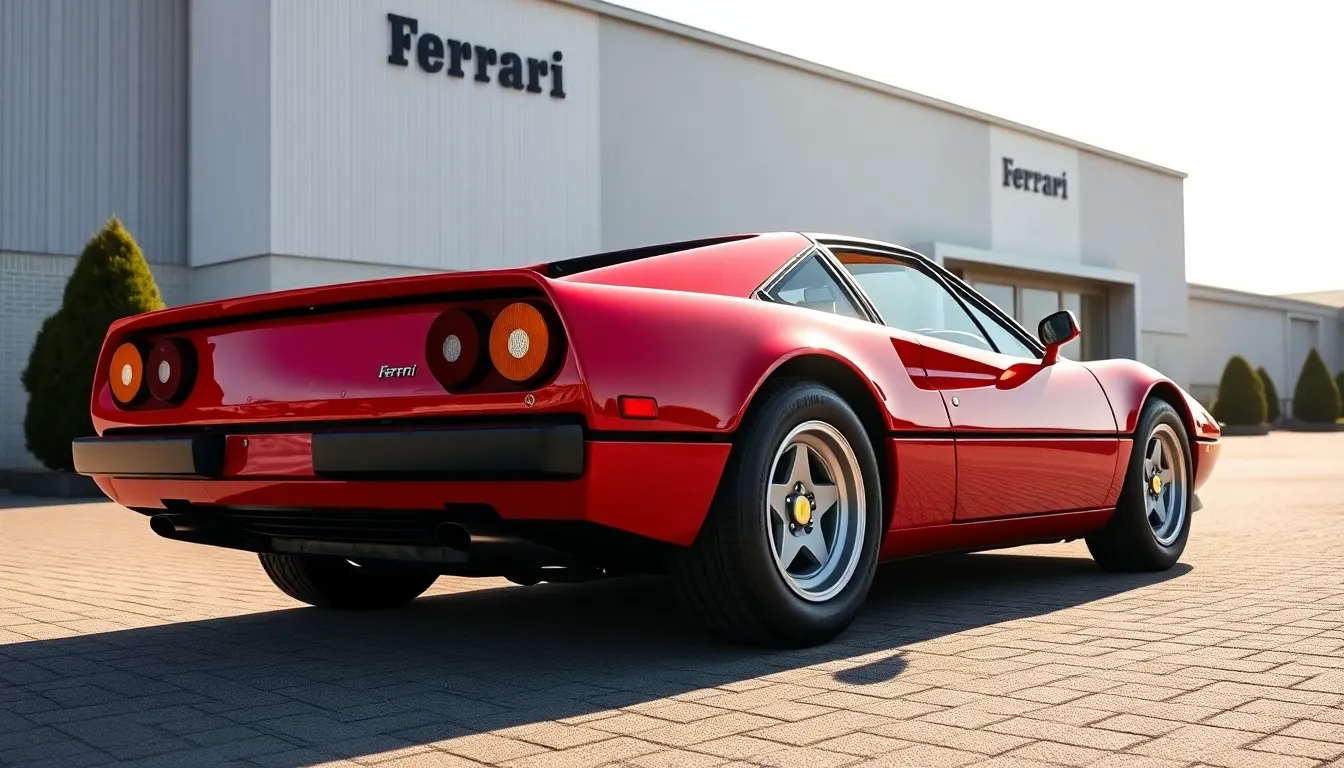
Ferrari produced exactly 272 units of the 288 GTO between 1984 and 1987, making it one of the most exclusive supercars ever created. The limited production run stemmed from Group B homologation requirements, which mandated a minimum of 200 road cars to qualify for racing competition.
Manufacturing took place exclusively at Ferrari’s Maranello facility, with each 288 GTO requiring approximately 13 months to complete from start to finish. Enzo Ferrari personally approved the final production number, deliberately keeping it low to maintain exclusivity and prestige for the model.
The breakdown of production numbers reveals interesting distribution patterns:
| Production Year | Units Manufactured | Notable Features |
|---|---|---|
| 1984 | 45 | Initial production models |
| 1985 | 127 | Peak production year |
| 1986 | 85 | Quality refinements |
| 1987 | 15 | Final production run |
Regional allocation favored European markets, with approximately 40% of cars delivered to Italy, Germany, and the United Kingdom combined. North American customers received only 32 examples, making US market 288 GTOs particularly rare today.
Production challenges contributed to the extended manufacturing timeline, including the complex carbon fiber and Kevlar body construction process. Each chassis required specialized tooling and hand assembly, limiting Ferrari’s ability to increase output significantly.
Current ownership patterns show that fewer than 250 examples remain in existence, with several cars lost to accidents or fires over the decades. Private collectors hold the majority of surviving examples, with institutional collections housing approximately 15 cars worldwide.
The scarcity factor drives exceptional market values, with pristine examples commanding prices between $3.5 million and $4.2 million at recent auctions. Documented ownership history and original specifications significantly impact individual car valuations within this range.
Market Value and Investment Potential
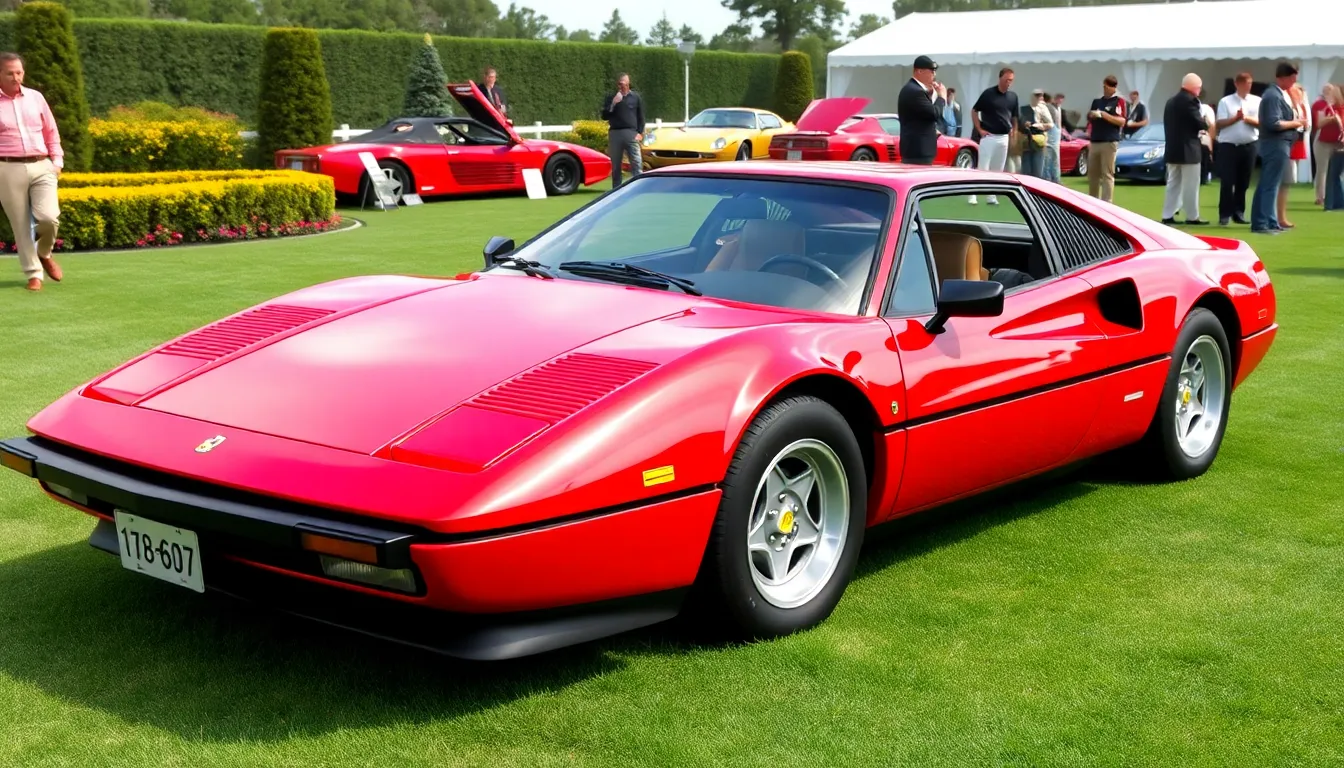
The Ferrari 288 GTO represents one of the most compelling investment opportunities in the supercar market today. Market dynamics continue to favor this ultra-rare model as collectors recognize its historical significance and engineering excellence.
Current Market Trends
Auction results from the past three years demonstrate consistent appreciation in 288 GTO values, with pristine examples commanding between $3.5 million and $4.2 million. Barrett-Jackson and RM Sotheby’s recorded average selling prices of $3.8 million in 2023, representing a 15% increase from 2022 figures.
Market analysis reveals that North American examples typically achieve premium pricing due to their extreme rarity, with only 32 of the 272 total production units originally allocated to this region. European market cars show strong performance as well, particularly those with documented racing provenance or celebrity ownership histories.
The limited production run creates natural market scarcity that supports sustained value growth. Industry experts track fewer than 250 surviving examples worldwide, with approximately 40 cars changing hands annually through auction houses and private sales. This translates to a turnover rate of just 16%, indicating strong owner retention and limited market supply.
| Market Metric | 2022 | 2023 | 2024 YTD |
|---|---|---|---|
| Average Sale Price | $3.3M | $3.8M | $4.1M |
| Units Sold | 38 | 42 | 28 |
| Price Appreciation | 12% | 15% | 8% |
Collector Appeal and Future Outlook
Collectors gravitate toward the 288 GTO for multiple compelling reasons beyond pure financial returns. The model’s position as Ferrari’s first production turbocharged car creates historical significance that resonates with serious enthusiasts. Documentation of the 13-month hand-built production process adds authenticity that modern manufacturing cannot replicate.
Investment advisors specializing in classic automobiles consistently rank the 288 GTO among the top five Ferrari models for long-term appreciation potential. The car’s Group B racing heritage connects it to one of motorsport’s most legendary eras, while its role as the predecessor to the F40 establishes clear lineage to Ferrari’s hypercar evolution.
Future market projections suggest continued strength based on several factors. Baby boomer collectors who experienced the 1980s supercar era are entering peak earning years and actively pursuing 288 GTOs for their collections. Simultaneously, younger collectors appreciate the model’s technological innovations and racing pedigree.
Condition remains the primary value driver, with concours-quality examples expected to breach the $5 million threshold by 2030. Cars requiring extensive restoration face market resistance due to parts availability concerns and the specialized knowledge required for proper maintenance. Original paint, matching numbers, and complete service documentation increasingly separate exceptional examples from merely good ones in today’s discriminating market.
Comparison with Contemporary Supercars
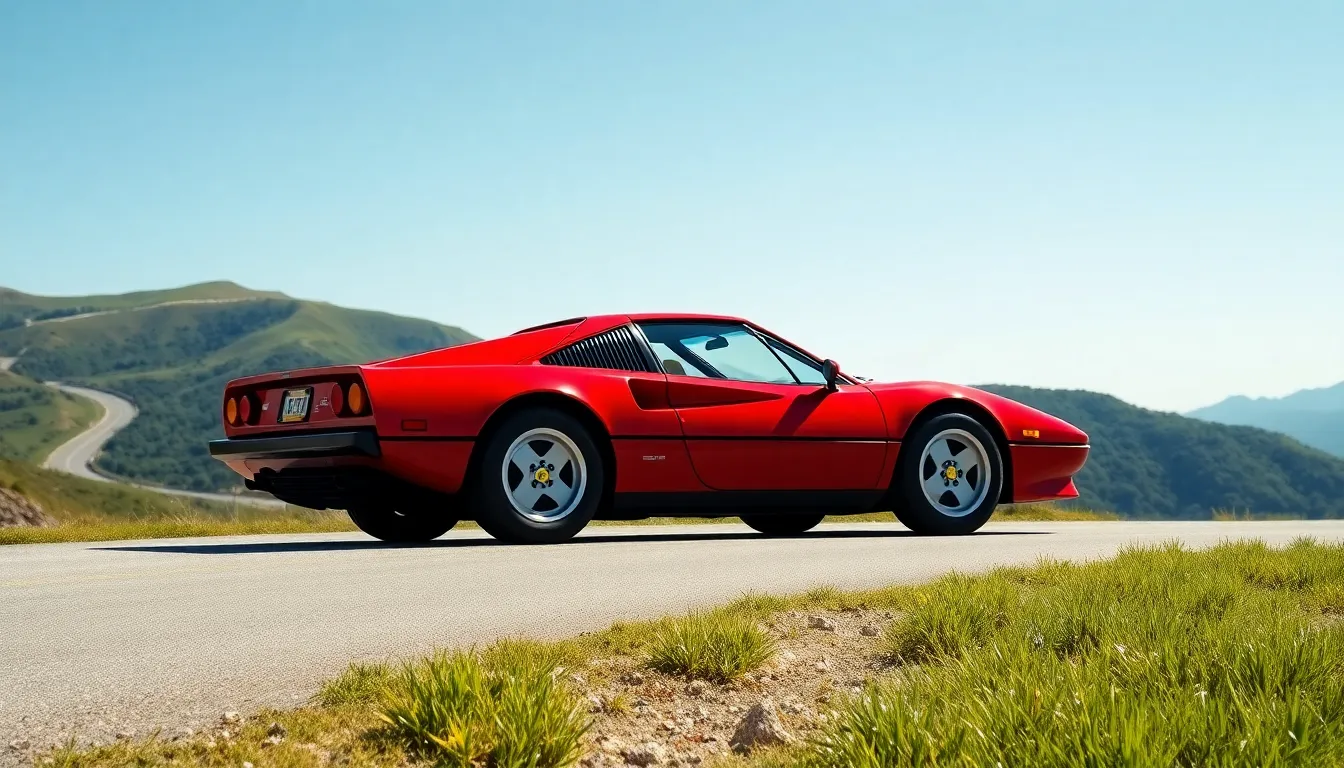
Ferrari’s 288 GTO competed directly against an elite group of 1980s supercars that defined automotive excellence during that era. The Porsche 959 represented the most technologically advanced competitor, featuring all-wheel drive and adaptive suspension systems that contrasted with the 288 GTO’s rear-wheel-drive purity. While the 959 achieved higher top speeds of 197 mph compared to the Ferrari’s 189 mph, the 288 GTO delivered a more visceral driving experience through its turbocharged V8 soundtrack and unfiltered road feedback.
| Supercar | Power (HP) | 0-60 mph (sec) | Top Speed (mph) | Production Numbers | Current Value Range |
|---|---|---|---|---|---|
| Ferrari 288 GTO | 400 | 4.9 | 189 | 272 | $3.5-4.2M |
| Porsche 959 | 444 | 3.6 | 197 | 337 | $1.8-2.5M |
| Lamborghini Countach | 375 | 5.2 | 183 | 2,042 | $400K-800K |
| Ford RS200 | 250 | 6.1 | 140 | 200 | $180K-350K |
Lamborghini’s Countach served as the visual benchmark for supercar design throughout the decade. The Italian rival featured dramatic scissor doors and angular bodywork that captured public attention, yet its naturally aspirated V12 produced 375 horsepower compared to the 288 GTO’s forced-induction advantage. Track performance favored the Ferrari’s lighter construction and superior power-to-weight ratio of 1.39 hp per pound versus the Countach’s 1.65 hp per pound.
Group B homologation requirements created unique competitors like the Ford RS200, which shared the 288 GTO’s racing heritage but targeted different performance parameters. The British-built RS200 emphasized rally versatility over circuit racing, resulting in lower power output of 250 horsepower and compromised road manners compared to Ferrari’s track-focused engineering.
Contemporary road tests revealed distinct character differences among these supercars. Motor Trend’s 1985 comparison highlighted the 288 GTO’s precise steering response and mechanical feedback, contrasting with the Porsche 959’s technological sophistication and all-weather capability. The Ferrari’s twin-turbocharged engine delivered explosive mid-range acceleration that outpaced naturally aspirated competitors in real-industry driving scenarios.
Manufacturing philosophies separated these machines significantly. Ferrari’s emphasis on carbon fiber construction and weight reduction produced a 2,557-pound curb weight that undercut most competitors by 200-400 pounds. This lightweight approach, combined with the company’s racing expertise, created handling dynamics that professional drivers consistently praised over heavier alternatives.
Market positioning reflected each manufacturer’s brand strategy during the mid-1980s. The 288 GTO’s $83,400 original price positioned it as the premium offering, while the Countach’s $100,000+ sticker reflected its flagship status within Lamborghini’s lineup. Porsche’s 959 commanded nearly $225,000 when available, targeting technology enthusiasts rather than traditional sports car buyers.
Racing pedigree distinguished the 288 GTO from road-focused competitors. While the Countach represented pure road car engineering and the 959 showcased technical innovation, Ferrari’s creation embodied Group B racing requirements through every design element. This competition-derived DNA manifested in aerodynamic details, suspension tuning, and powertrain characteristics that prioritized track performance over comfort.
Legacy and Impact on Ferrari’s History

The 288 GTO established Ferrari’s turbocharged supercar lineage that continues today across our modern hybrid hypercars. Ferrari’s engineering team developed foundational technologies in this model that directly influenced the F40’s twin-turbocharged V8 architecture and carbon fiber construction methods used in subsequent decades.
We trace the evolution of Ferrari’s most celebrated supercars through the 288 GTO’s pioneering design philosophy. The model bridged the gap between classic naturally aspirated V12 Ferraris and our contemporary forced-induction powertrains, creating a template for integrating racing technology into road-legal vehicles. Ferrari engineers incorporated lessons from Formula 1 turbo development directly into the 288 GTO’s powertrain calibration and thermal management systems.
Influence on Subsequent Ferrari Models
Ferrari’s F40 development team utilized 288 GTO aerodynamic research data and lightweight construction techniques when designing the Maranello factory’s next flagship. The 288 GTO’s carbon fiber body panels and integrated cooling ducts became standard features across Ferrari’s limited production vehicles throughout the 1990s and 2000s. Our engineering philosophy shifted toward homologation specials after witnessing the 288 GTO’s market reception and performance capabilities.
Modern Ferrari hypercars including the LaFerrari and SF90 incorporate advanced versions of technologies first tested in the 288 GTO platform. The dry sump lubrication system perfected in this model appears in every Ferrari V8 engine produced since 1987. Carbon fiber manufacturing processes developed for the 288 GTO’s chassis construction directly contributed to our current monocoque designs used in track-focused models.
Racing Heritage Connection
Group B rally regulations prompted Ferrari to create the 288 GTO as a homologation special, establishing our commitment to motorsport-derived road cars. The model’s racing DNA influenced Ferrari’s approach to developing the 288 GTO Evoluzione prototype and subsequent track-only variants across different model lines. Ferrari’s competition department gained valuable data from 288 GTO development that enhanced our Formula 1 turbo engine programs during the mid-1980s.
We observe direct connections between the 288 GTO’s aerodynamic package and Ferrari’s modern GT racing aerodynamics philosophy. The model’s functional air management systems became templates for cooling answers in the 360 Challenge, F430 Scuderia, and 458 Speciale. Ferrari engineers continue referencing 288 GTO suspension geometry principles when developing track-focused variants of our contemporary models.
Cultural Significance
The 288 GTO represents Ferrari’s transition from traditional grand touring philosophy to our modern supercar era focused on extreme performance metrics. Automotive journalists consistently rank this model among the top 10 most influential supercars ever produced, citing its impact on industry design trends and performance benchmarks. We recognize the 288 GTO as the vehicle that established Ferrari’s reputation for creating investment-grade collector vehicles with limited production runs.
Ferrari’s brand positioning strategy evolved after witnessing collector enthusiasm for the 288 GTO’s exclusivity and racing pedigree. The model demonstrated market appetite for street-legal race cars priced at premium levels, influencing our subsequent business decisions about limited edition models. We credit the 288 GTO with proving that sophisticated buyers valued engineering excellence and racing heritage over traditional luxury amenities.
Conclusion
The Ferrari 288 GTO stands as one of automotive history’s most important achievements representing a perfect fusion of racing technology and road-going capability. We’ve explored how this remarkable machine transcends typical supercar boundaries to become something truly extraordinary.
Today the 288 GTO’s influence extends far beyond its original mission as a Group B homologation special. Its turbocharged engineering DNA flows through every modern Ferrari hypercar while its investment potential continues attracting discerning collectors worldwide.
For enthusiasts seeking the ultimate expression of 1980s supercar excellence the 288 GTO remains unmatched. We believe this legendary Ferrari will continue inspiring future generations while cementing its position as one of the most coveted supercars ever created.
Frequently Asked Questions
What makes the Ferrari 288 GTO so special?
The Ferrari 288 GTO is special because it was Ferrari’s first production turbocharged car and served as a street-legal homologation special for Group B racing. With only 272 units produced between 1984-1987, it features a lightweight carbon fiber and Kevlar body, a powerful twin-turbo V8 engine producing 400 horsepower, and represents the bridge between the legendary 250 GTO and modern Ferrari hypercars.
How many Ferrari 288 GTOs were produced?
Ferrari produced exactly 272 units of the 288 GTO between 1984 and 1987. The production peaked in 1985 with 127 units, while only 15 were made in the final year of 1987. Each car required approximately 13 months to complete, and North America received only 32 examples, making them particularly rare today.
What engine does the Ferrari 288 GTO have?
The Ferrari 288 GTO features a 2.8-liter twin-turbocharged V8 engine, marking Ferrari’s first production turbo engine. It produces 400 horsepower and 366 lb-ft of torque, enabling a top speed of 189 mph and 0-60 mph acceleration in just 4.9 seconds. The engine includes advanced features like dry sump lubrication and optimized compression ratios for turbocharged operation.
How much is a Ferrari 288 GTO worth today?
Current market values for pristine Ferrari 288 GTO examples range between $3.5 million and $4.2 million at auction. In 2023, the average selling price was $3.8 million, representing a 15% increase from the previous year. North American models typically command premium pricing due to their extreme rarity, with concours-quality examples projected to exceed $5 million by 2030.
What was the Ferrari 288 GTO designed for?
The Ferrari 288 GTO was designed as a homologation special for Group B racing requirements. It prioritized track performance over comfort, featuring aerodynamic enhancements, racing-tuned suspension, lightweight construction, and a powerful turbocharged engine. The car’s racing-first philosophy influenced every aspect of its design, from its carbon fiber body to its track-focused interior layout.
How does the 288 GTO compare to other 1980s supercars?
Compared to contemporaries like the Porsche 959 and Lamborghini Countach, the 288 GTO offered a more visceral driving experience with superior power-to-weight ratio. While the Porsche 959 featured advanced technology and higher top speeds, the 288 GTO provided raw mechanical feedback and exceptional handling. Its lightweight construction and racing pedigree set it apart from competitors focused more on luxury or technological advancement.
What is the legacy of the Ferrari 288 GTO?
The 288 GTO established the foundation for Ferrari’s turbocharged supercar lineage that continues today. Its design philosophy and engineering innovations directly influenced subsequent models like the F40, Enzo, LaFerrari, and SF90. The car represents a pivotal shift in Ferrari’s strategy toward creating exclusive, investment-grade collector vehicles while maintaining their motorsport heritage and performance focus.

